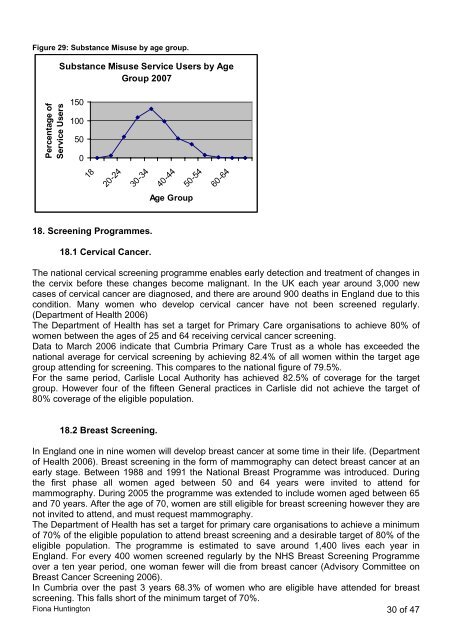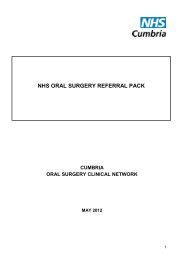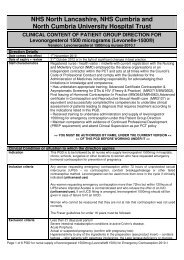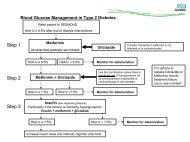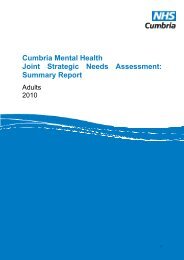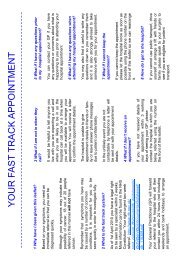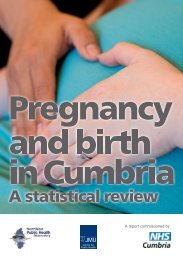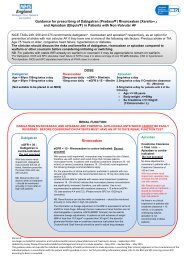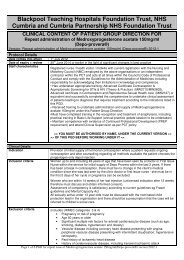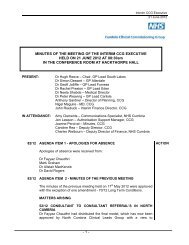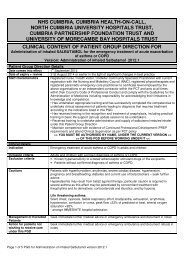Carlisle is the most northerly city in England, and the ... - NHS Cumbria
Carlisle is the most northerly city in England, and the ... - NHS Cumbria
Carlisle is the most northerly city in England, and the ... - NHS Cumbria
- No tags were found...
Create successful ePaper yourself
Turn your PDF publications into a flip-book with our unique Google optimized e-Paper software.
Figure 29: Substance M<strong>is</strong>use by age group.Substance M<strong>is</strong>use Service Users by AgeGroup 2007Percentage ofService Users1501005001820-2430-3440-4450-5460-64Age Group18. Screen<strong>in</strong>g Programmes.18.1 Cervical Cancer.The national cervical screen<strong>in</strong>g programme enables early detection <strong>and</strong> treatment of changes <strong>in</strong><strong>the</strong> cervix before <strong>the</strong>se changes become malignant. In <strong>the</strong> UK each year around 3,000 newcases of cervical cancer are diagnosed, <strong>and</strong> <strong>the</strong>re are around 900 deaths <strong>in</strong> <strong>Engl<strong>and</strong></strong> due to th<strong>is</strong>condition. Many women who develop cervical cancer have not been screened regularly.(Department of Health 2006)The Department of Health has set a target for Primary Care organ<strong>is</strong>ations to achieve 80% ofwomen between <strong>the</strong> ages of 25 <strong>and</strong> 64 receiv<strong>in</strong>g cervical cancer screen<strong>in</strong>g.Data to March 2006 <strong>in</strong>dicate that <strong>Cumbria</strong> Primary Care Trust as a whole has exceeded <strong>the</strong>national average for cervical screen<strong>in</strong>g by achiev<strong>in</strong>g 82.4% of all women with<strong>in</strong> <strong>the</strong> target agegroup attend<strong>in</strong>g for screen<strong>in</strong>g. Th<strong>is</strong> compares to <strong>the</strong> national figure of 79.5%.For <strong>the</strong> same period, <strong>Carl<strong>is</strong>le</strong> Local Authority has achieved 82.5% of coverage for <strong>the</strong> targetgroup. However four of <strong>the</strong> fifteen General practices <strong>in</strong> <strong>Carl<strong>is</strong>le</strong> did not achieve <strong>the</strong> target of80% coverage of <strong>the</strong> eligible population.18.2 Breast Screen<strong>in</strong>g.In <strong>Engl<strong>and</strong></strong> one <strong>in</strong> n<strong>in</strong>e women will develop breast cancer at some time <strong>in</strong> <strong>the</strong>ir life. (Departmentof Health 2006). Breast screen<strong>in</strong>g <strong>in</strong> <strong>the</strong> form of mammography can detect breast cancer at anearly stage. Between 1988 <strong>and</strong> 1991 <strong>the</strong> National Breast Programme was <strong>in</strong>troduced. Dur<strong>in</strong>g<strong>the</strong> first phase all women aged between 50 <strong>and</strong> 64 years were <strong>in</strong>vited to attend formammography. Dur<strong>in</strong>g 2005 <strong>the</strong> programme was extended to <strong>in</strong>clude women aged between 65<strong>and</strong> 70 years. After <strong>the</strong> age of 70, women are still eligible for breast screen<strong>in</strong>g however <strong>the</strong>y arenot <strong>in</strong>vited to attend, <strong>and</strong> must request mammography.The Department of Health has set a target for primary care organ<strong>is</strong>ations to achieve a m<strong>in</strong>imumof 70% of <strong>the</strong> eligible population to attend breast screen<strong>in</strong>g <strong>and</strong> a desirable target of 80% of <strong>the</strong>eligible population. The programme <strong>is</strong> estimated to save around 1,400 lives each year <strong>in</strong><strong>Engl<strong>and</strong></strong>. For every 400 women screened regularly by <strong>the</strong> <strong>NHS</strong> Breast Screen<strong>in</strong>g Programmeover a ten year period, one woman fewer will die from breast cancer (Adv<strong>is</strong>ory Committee onBreast Cancer Screen<strong>in</strong>g 2006).In <strong>Cumbria</strong> over <strong>the</strong> past 3 years 68.3% of women who are eligible have attended for breastscreen<strong>in</strong>g. Th<strong>is</strong> falls short of <strong>the</strong> m<strong>in</strong>imum target of 70%.Fiona Hunt<strong>in</strong>gton 30 of 47


